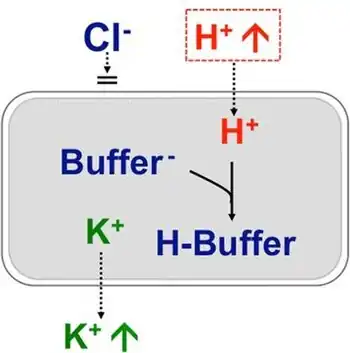Hyperchloremic acidosis
| Hyperchloremic acidosis | |
|---|---|
| Other names: Hyperchloremic metabolic acidosis [1] | |
 | |
| Effect of hyperchloremic metabolic acidosis on circulating K+ level(some extracellular H+ shifts into the intracellular space)[2] | |
Hyperchloremic acidosis is a form of metabolic acidosis associated with a normal anion gap, a decrease in plasma bicarbonate concentration, and an increase in plasma chloride concentration[3] (see anion gap for a fuller explanation). Although plasma anion gap is normal, this condition is often associated with an increased urine anion gap, due to the kidney's inability to secrete ammonia. In general, the cause of a hyperchloremic metabolic acidosis is a loss of base, either a gastrointestinal loss or a renal loss.
- Gastrointestinal loss of bicarbonate (HCO−
3)- Severe diarrhea (vomiting will tend to cause hypochloraemic alkalosis)
- Pancreatic fistula with loss of bicarbonate rich pancreatic fluid
- Nasojejunal tube losses in the context of small bowel obstruction and loss of alkaline proximal small bowel secretions
- Chronic laxative abuse
- Renal causes
- Proximal renal tubular acidosis with failure of HCO−
3 resorption - Distal renal tubular acidosis with failure of H+
secretion - Long-term use of a carbonic anhydrase inhibitor such as acetazolamide
- Proximal renal tubular acidosis with failure of HCO−
- Other causes
- Ingestion of ammonium chloride, hydrochloric acid, or other acidifying salts
- The treatment and recovery phases of diabetic ketoacidosis
- Volume resuscitation with 0.9% normal saline provides a chloride load, so that infusing more than 3-4L can cause acidosis
- Hyperalimentation (i.e., total parenteral nutrition)
See also
References
- ↑ Sharma, Sandeep; Hashmi, Muhammad F.; Aggarwal, Sandeep (2023). "Hyperchloremic Acidosis". StatPearls. StatPearls Publishing. Archived from the original on 2024-01-24. Retrieved 2024-01-22.
- ↑ Santi, Maristella; Lava, Sebastiano A. G.; Camozzi, Pietro; Giannini, Olivier; Milani, Gregorio P.; Simonetti, Giacomo D.; Fossali, Emilio F.; Bianchetti, Mario G.; Faré, Pietro B. (25 June 2015). "The great fluid debate: saline or so-called "balanced" salt solutions?". Italian Journal of Pediatrics. 41: 47. doi:10.1186/s13052-015-0154-2. ISSN 1824-7288. Archived from the original on 24 January 2024. Retrieved 22 January 2024.
- ↑ "Hyperchloremic Acidosis: Practice Essentials, Etiology, Patient Education". 2017-10-19. Archived from the original on 2024-01-24. Retrieved 2023-11-03.
{{cite journal}}: Cite journal requires|journal=(help)
Further reading
- Kellum JA (February 2002). "Fluid resuscitation and hyperchloremic acidosis in experimental sepsis: improved short-term survival and acid-base balance with Hextend compared with saline". Crit. Care Med. 30 (2): 300–5. doi:10.1097/00003246-200202000-00006. PMID 11889298. S2CID 24375350.
External links
| Classification | |
|---|---|
| External resources |
This article is issued from Wmcloud. The text is licensed under Creative Commons - Attribution - Sharealike. Additional terms may apply for the media files.